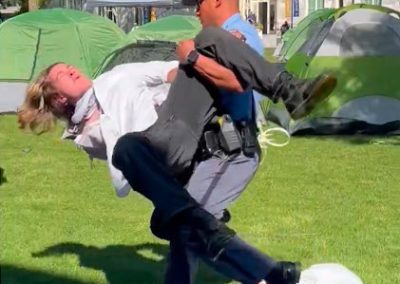Cops and firefighters like to make good natured fun of each other. I’ve heard cops call firefighters “second responders,” and every cop knows the look of sleepy firefighters just called out of bed in the middle of the night. I bring up these examples because they speak to this truth: Cops can get themselves seriously injured when they feel they can’t wait for the fire department to arrive.
When a structure fire gets called in to 911, the police and fire department often receive those calls simultaneously. Because cops are out prowling the streets anyway, it’s often the case that they will be first on scene. The problem is, there are many important aspects of compartment fires that cops are ignorant about—aspects that could get us killed.
It would be prudent to understand a little bit about how fire works so we can protect ourselves and others and hopefully preserve as much evidence as possible for the fire investigators.
Backdraft
Backdraft is a type of explosion called a deflagration that occurs when fresh air is suddenly introduced into a compartment containing products of incomplete combustion.
What does that mean to a cop? Fire needs only a few things to burn: fuel, oxygen, and heat. Sometimes a fire may be contained to one compartment in a house—a bedroom, for example—where the fire has become oxygen deficient. The compartment may maintain enough heat and fuel to continue burning, but it just needs the reintroduction of oxygen to start up again. When you, the cop, kick open the bedroom door or smash out the window, oxygen to rushes into the room and in many cases an explosion is the result.
Many police officers might not realize that smoke is itself combustible. We often think of smoke as only the byproduct of combustion, but the smoke contains many unburned products of combustion that will burn, given the chance.
Everybody has heard that smoke is the most dangerous part of the fire. It’s true: Smoke inhalation is deadly and kills more people than fire itself. But the danger of the smoke, often called the hot gas layer, is much more dangerous than cops might think.
Flashover
Flashover is a recently understood phenomenon even in the firefighting world, one that’s unlikely to be known by most cops. Flashover is the name for a sudden transition in a compartment fire in which the hot gas layer plays a vital role. Firefighters sometimes refer to flashover as the transition from a “fire in a room” to “a room on fire.” The following video makes that expression come to life.
Flashover is an important concept for cops to understand because the room can transition almost immediately. As the hot gas layer spreads throughout a room or house it radiates an incredible amount of heat down onto items far from the actual flames. That radiant heat can start a process called pyrolysis on solid fuels not even near the flames. Once the radiant heat reaches a certain heat flux measurement (20 kW/m2) then flashover can occur.
Flashover causes flaming combustion to all combustible fuels in a compartment—even if they aren’t near flame. A heat flux of 20kW/m2 will ignite crumpled newspaper not in contact with flame. Once flashover occurs, the heat flux reading increases rapidly to as high as 170 kW/m2. For some context, a heat flux of 6.4 kW/m2 will cause second-degree burns and blister human skin in about 18 seconds. That is not a survivable environment.
Lessons from Firefighters
I have personally responded to many structure fires during my career as a police officer. It’s the reality of the situation that police often arrive at the fire scenes minutes before the fire department and officer actions during that time are critical. Police and fire departments have started training together a great deal to enhance their ability to respond to active shooter and mass-emergency situations, but this should be expanded. Fire instructors should be given some time with police academies to educate police recruits on the dangers of fire and the proper response to structure fires.
Police officers must be incredibly careful if they find themselves at the scene of a structure fire. Deciding to go inside the structure can mean causing backdrafts or being caught inside when flashover occurs. Additionally, causing backdrafts or accelerating a fire to flashover means potentially destroying a lot of evidence fire investigators use to determine cause and origin. Rescuing people takes precedence, of course, but recognizing our own ignorance of fire dynamics might mean avoiding becoming an additional victim or destroying evidence.
Scot DuFour began his career in law enforcement with the Phoenix, Ariz., Police Department in 2004 and worked primarily on patrol in South Phoenix. In 2008, Scot moved to Colorado and transferred to the Aurora, Colorado Police Department where he worked until 2018. Scot is currently a criminal investigator for a district attorney’s office in the Denver area.
Scot has an AAS in Law Enforcement Technology with honors, a BA in Philosophy with a concentration in ethics, magna cum laude, and a Master’s Degree in Criminal Justice with honors.










Backdrafts are a very rare event on the fire ground. The larger concern with opening doors or breaking windows is changing the flow path of the air. Fire is a gaseous reaction. Control the movement of the heated gases and the oxygen and you control the fire. Much has changed in firefighting after NIST/UL started building houses in large warehouses and setting them on fire. It was an arson case in Texas that almost cost us the death penalty. The science the investigator used in his investigation were shown to be junk science after the NIST/UL tests. In his defense, the junk science was passed from one generation of investigators to the next. Firefighters were taught in in Fire Behavior degree programs the same junk science. NIST/UL changed all that within the last three years. It invalidated so much that had been taught for so long. The NIST/UL studies are showing flashover occurs much faster due to so many consumer products, including furniture, being made from petroleum based products. The studies are showing residents have far less time to escape a house fire today than 20 years ago and far less time than 40 years ago when things were made of real wood and real cotton.
The take away is controlling the air flow controls the fire. On a noticeable windy day, if an officer has the wind to her back and opens a door or breaks a window, it will feed the fire.
The best course of action for officers first on scene of a structure fire is to first and foremost, don’t put your squad car in any spot where it is the closest to the building. As the saying goes, you can stretch more hose, but you can’t stretch a ladder. It is crucial to leave room for the first arriving truck company or quint (has the large ladder on top).
.
Closing doors can help contain the fire.
If you have to go in for a rescue, stay at floor level. One breath standing up can be enough to kill you. Use your baton to sweep the floor if the smoke conditions are bad. Know that if you need to sweep the floor with your baton due to smoke conditions you have very little time before the flashover.
A better strategy is to get to an exit set your flashlight on the ground shining into the structure then call out to the people inside to give victims an idea where to exit the building.
You can put out a significant amount of fire with a garden hose (if the fire department is really far off)
https://www.youtube.com/watch?v=-QH9LWNW1lc
Every cop in the country should be required to watch the video of the Station Night Club Fire that killed 99 people to see how fast the fire spreads, how intoxicated people can jam an exit, and what would have happened if you beat the fire department and went inside when the fire started.
Watch the video and make a note of the time in the fire when you think everyone inside are dead (it has minute and half minute marks from the start of the fire.)
Note in the fire at the 5 minute mark in the youtube part of the video. That open door is feeding the fire.
https://www.youtube.com/watch?v=xY59mR44TLs
After watching the video, go back and look at 6:23 in the youtube video for someone running out of the building on fire.
Think you would be alive if you were working at or near the nightclub and went inside to see the fire?
Great post. Thank you!